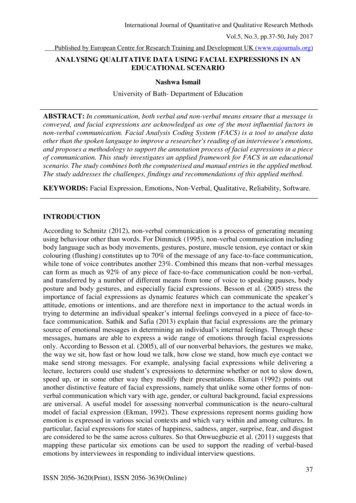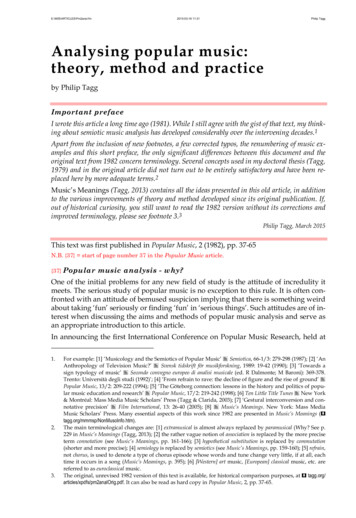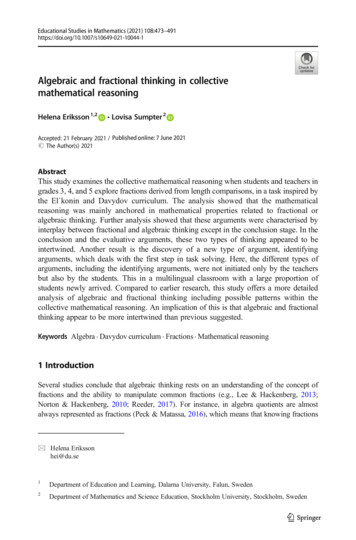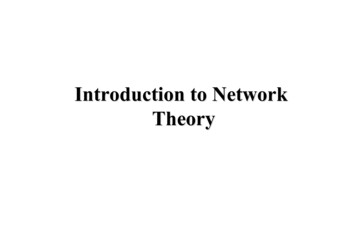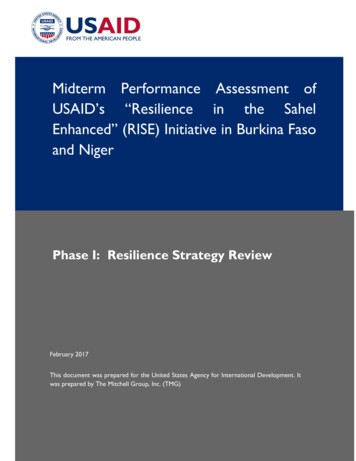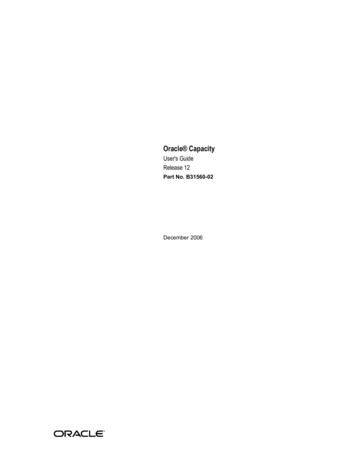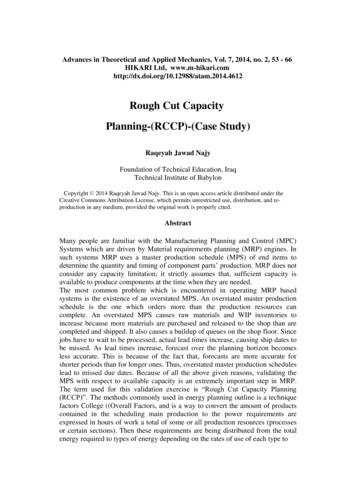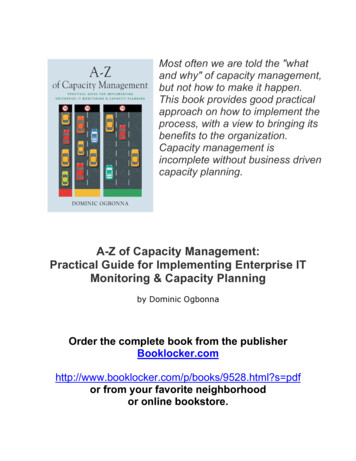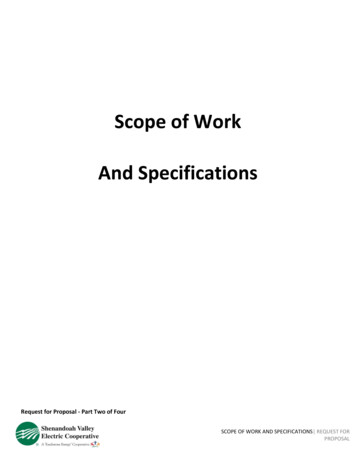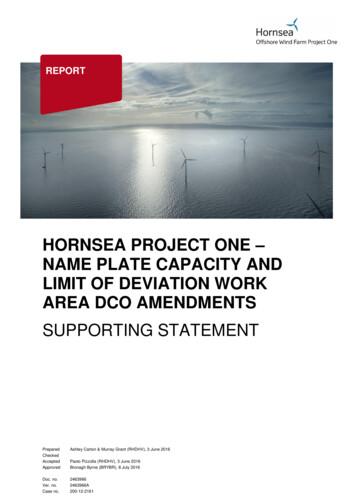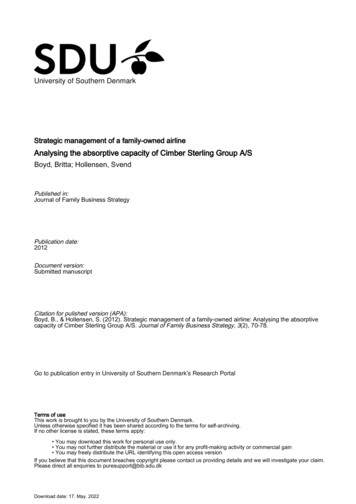
Transcription
University of Southern DenmarkStrategic management of a family-owned airlineAnalysing the absorptive capacity of Cimber Sterling Group A/SBoyd, Britta; Hollensen, SvendPublished in:Journal of Family Business StrategyPublication date:2012Document version:Submitted manuscriptCitation for pulished version (APA):Boyd, B., & Hollensen, S. (2012). Strategic management of a family-owned airline: Analysing the absorptivecapacity of Cimber Sterling Group A/S. Journal of Family Business Strategy, 3(2), 70-78.Go to publication entry in University of Southern Denmark's Research PortalTerms of useThis work is brought to you by the University of Southern Denmark.Unless otherwise specified it has been shared according to the terms for self-archiving.If no other license is stated, these terms apply: You may download this work for personal use only. You may not further distribute the material or use it for any profit-making activity or commercial gain You may freely distribute the URL identifying this open access versionIf you believe that this document breaches copyright please contact us providing details and we will investigate your claim.Please direct all enquiries to puresupport@bib.sdu.dkDownload date: 17. May. 2022
This article appeared in a journal published by Elsevier. The attachedcopy is furnished to the author for internal non-commercial researchand education use, including for instruction at the authors institutionand sharing with colleagues.Other uses, including reproduction and distribution, or selling orlicensing copies, or posting to personal, institutional or third partywebsites are prohibited.In most cases authors are permitted to post their version of thearticle (e.g. in Word or Tex form) to their personal website orinstitutional repository. Authors requiring further informationregarding Elsevier’s archiving and manuscript policies areencouraged to visit:http://www.elsevier.com/copyright
Author's personal copyJournal of Family Business Strategy 3 (2012) 70–78Contents lists available at SciVerse ScienceDirectJournal of Family Business Strategyjournal homepage: www.elsevier.com/locate/jfbsStrategic management of a family-owned airline: Analysing the absorptivecapacity of Cimber Sterling Group A/SBritta Boyd *, Svend Hollensen 1University of Southern Denmark, Department for Border Region Studies, Alsion 2, 6400 Sønderborg, DenmarkA R T I C L E I N F OA B S T R A C TArticle history:Received 31 August 2011Received in revised form 2 March 2012Accepted 11 March 2012The concept of absorptive capacity (ACAP) observing a firm’s ability to value, assimilate and utilise newexternal knowledge is applied in this paper. This case study analysis focuses on the strategicmanagement processes and competitiveness of the Cimber Sterling airline. The aim is to discoverresources and capabilities that lead to competitive advantages within the aviation industry. From anACAP perspective, Cimber Sterling Group A/S was analysed by interviewing selected owners, managersand employees of the airline. A comparison within the airline industry regarding external factors and thestrategic management of other selected low-cost airlines is part of the ACAP concept. The analysis showsto what extent Cimber Sterling Group A/S, as a Danish family business, copes with increasingcompetition and critical situations, such as the recent volcanic ash cloud and the financial crisis.Identifying the potential and realised capacity of the strategic management of airlines was revealed as asource of strategic competitiveness. The ACAP was improved through stakeholder experience, strategicflexibility, networking capabilities and customer orientation, leading to a competitive advantagerealisation in the low-cost airline market.ß 2012 Elsevier Ltd. All rights reserved.Keywords:Absorptive capacityAviation industryCompetitive advantagesFamily firmsLow-cost airlinesStrategic management1. IntroductionMost international airlines are not family-owned, based on the50 percent control definition of a family business (Astrachan &Kolenko, 1994; Chua, Chrisman, & Sharma, 1999) where successionhas at least been planned. Using this definition, Bennedsen,Nielsen, and Wolfenzon (2004), when investigating 80,000registered businesses in Denmark for the years 1995–2002, foundthat 89.2 percent of privately held firms are family firms. For othercountries, the estimate of the share of family ownership liesbetween 65 and 80 percent, according to studies using smallersamples (Dreux, 1990; Gersick, Davis, McCollom Hampton, &Lansberg, 1997; Lansberg, 1999; Ward, 1987). Although Denmarkhas a relatively high percentage of family businesses, research inthe area of family businesses is predominantly limited to the fieldsof entrepreneurship and small- and medium-sized enterprises(Schøtt, 2007, 2008), selected case studies or industry-relatedresearch (Boyd, Goto, & Hollensen, 2010; Getz & Nilsson, 2004).Therefore, a Danish family-owned airline such as Cimber SterlingGroup A/S (shortened in the following text to Cimber) provides aninteresting case for investigation.* Corresponding author. Tel.: 45 6550 1756; fax: 45 6550 1779.E-mail addresses: bri@sam.sdu.dk (B. Boyd), svend@sam.sdu.dk (S. Hollensen).1Tel.: 45 6550 1218; fax: 45 6550 1779.1877-8585/ – see front matter ß 2012 Elsevier Ltd. All rights reserved.doi:10.1016/j.jfbs.2012.03.003Traditional literature on strategic management explainscompetitive advantages mainly by focusing on external factors(e.g., Barney, 1991; Porter, 1991), which has also been the mainapproach in explaining the competiveness of the Emirate Airlines(Nataraja & Al-Aali, 2011). Compared to this traditional approach,the ACAP perspective as applied in this study is better able toexplain how the organisation and its members understand, absorband respond to environmental changes. The dynamics of the ACAPconcept first introduced by Cohen and Levinthal (1990) can alsoexplain how sudden changes in the airline environment (e.g., thevolcano ash crisis) can elicit fast decisions because it focuses on theinternal decision-making environment of the company.The international behaviour of family businesses differs fromnon-family businesses because of different competences andvalues (Casillas, Acedo, & Moreno, 2007). However, it has not yetbeen determined how family businesses use these competences intheir strategic management. In the aviation industry, there existsonly a small number of family businesses. The strategic management of Cimber, a Danish family business, and its implications forcompetitiveness will be the focus of this case study analysis. Thefour non-family airlines that compete with Cimber in the low-costleisure segment were selected by the owner and validatedaccording to industry information.The overall purpose of this study is to understand the strategicmanagement and development of a company’s competitiveadvantages from an ACAP perspective. More specifically, thefollowing research questions will be addressed in this study:
Author's personal copyB. Boyd, S. Hollensen / Journal of Family Business Strategy 3 (2012) 70–781. To what extent are the situational and structural triggersabsorbed and incorporated into the strategic managementdecisions of Cimber?2. What prior knowledge and personal capabilities of the ownersand employees lead to corporate competences of Cimber?3. Which internal and external factors have an influence on thecompetitive advantage realisation of Cimber?2. Theoretical background and methodologyInternationalisation processes have been analysed with regardto family businesses in different industries and regions. Accordingly, the formation of networks, such as joint ventures (Boyd et al.,2010; Niemelä, 2004; Swinth & Vinton, 1993), and the development of specific capabilities play an important role in theinternationalisation process (Casillas et al., 2007; Fernández &Nieto, 2005; Graves & Thomas, 2006, 2008; Okoroafo, 1999).However, international strategic management as an on-goinginteractive process towards internationalisation (Hamel, 2000;Hamel & Prahalad, 1994) is an important aspect for family businessmanagement and should not be neglected.Prior research on organisational learning and strategic management focusing on the role of ACAP defined the concept of ACAPas the ‘‘ability of a firm to recognise the value of new, externalinformation, assimilate it, and apply it to commercial ends’’ (Cohen& Levinthal, 1990: 128).According to Bower and Hilgard (1981), prior related knowledge is needed to assimilate and use new knowledge. They arguethat the breadth and differentiation of categories into which priorknowledge is organised and the linkages across these categoriesenables individuals to absorb new knowledge. The history- orpath-dependency of ACAP and innovative performance explainsthat the creation of early expertise is particularly important for thefuture development of capabilities (Cohen & Levinthal, 1990).In a reconceptualisation, Zahra and George (2002: 198) defineACAP as a ‘‘set of knowledge based capabilities embedded withinthe firm’s routines and strategic processes’’ that enhances theability to gain and sustain competitive advantages. They differentiate the two subsets of potential and realised ACAP. The firstconsists of the capability to acquire externally generatedknowledge and the capability to assimilate or interpret thesesources. The second subset includes the capabilities to transform orcombine existing with acquired knowledge and the ability toexploit that knowledge. As a set of specific processes such asproduct development, strategic decision making and networking,dynamic capabilities evolve via well-known learning mechanisms.Dynamic capabilities build the basis for long-term competitiveadvantages realised by resource configurations (Eisenhardt &Martin, 2000). In that sense, dynamic capabilities can be seen as apotential ACAP and resource configuration can be considered arealised ACAP.This is why the focus of this case study is to analyse the ACAP ofCimber from a competence or capability perspective whenexamining its internationalisation strategies. The case studymethodology presented herein can explain management situations. To generalise case study results, the development of atheoretical framework and the testing of quality criteria areimportant (Bonoma, 1985; Eisenhardt, 1989; Eisenhardt &Graebner, 2007). All principles of data collection, according toYin (2009), were considered, including multiple sources, a casestudy database and chain of evidence. Yin’s reply to concerns aboutcase study generalisability is to argue that, like the experiment, thecase study generalises to the theoretical propositions and not tothe whole population (Yin, 2009). It is posited herein thatindividual competences of owners and employees as well asfactors that influence the absorptive capacity of an organisationcan lead to competitiveness when potential and realised capacitiesare being passed on (Cohen & Levinthal, 1990). These factors can befound in sociocultural values, norms and mechanisms thatfacilitate and influence knowledge generation and assimilationprocesses within an organisation (Lewin, Massini, & Peeters, 2011;Zahra & George, 2002). The assimilated and utilised knowledgesource will then lead to competitive advantages and the ability toaddress critical situations. The aviation industry was not onlyaffected by the financial crisis but also by the volcano ash cloud inApril 2010. Therefore, the investigation will examine the handlingof these critical situations from three different perspectives,namely, that of the owner, a stewardess and a pilot. In-depthqualitative interviews were carried out, transcribed and analysedaccording to the research questions.The research model in Fig. 1 was adapted from the ACAPreconceptualisation of Zahra and George (2002) and the dynamiccapability discussion from Eisenhardt and Martin (2000). Theirliterature review supported this model wherein the potentialcapacity or knowledge acquisition and assimilation can be seen as adynamic capability or personal competence. The realised capacity ofknowledge transformation and exploitation can be valued as a formof resource configuration or corporate competence. According toEisenhardt and Martin (2000), dynamic capabilities are the driversbehind the creation, evolution and recombination of other resourcesinto new sources of competitive advantage.In accordance with the abovementioned prior research, thisstudy will analyse the historical knowledge source and theexperience being absorbed from three different perspectives whenresponding to activation triggers. The ash cloud and recent oil priceincrease are regarded as situational triggers. Structural triggersreflect the financial crisis and the overall conditions in a saturatedmarket. This study will investigate how these triggers are absorbedas potential ACAP and transformed to realised ACAP. The ve capacityKnowledgesource andexperiencePotential ACAPRealized ACAPDynamic capabilityResource ernalfactorsSource: Adapted from Zahra & George (2002) and Eisenhardt& Martin (2000).Fig. 1. Research model.Source: Adapted from Zahra and George (2002) and Eisenhardt and Martin (2000).71
Author's personal copy72B. Boyd, S. Hollensen / Journal of Family Business Strategy 3 (2012) 70–78will take different factors of institutional and industry dynamicsinto account and determine which corporate competences can leadto competitive advantages. The financial support of an investorwas regarded as an internal factor and the competitive position ofCimber as an external factor. Following the abovementionedpathway, as illustrated in the research model (Fig. 1), the interviewguideline begins with some general questions and then moves tomore detailed questions about the personal and corporatecompetences.3. The competence and ACAP perspectiveThe concept of core competences can be viewed differentlywithin an organisation. From a strategic management perspective,competences are defined as a combination of resources andcapabilities (Hitt, Ireland, & Hoskisson, 2005). In an organisation,the combination of resources and capabilities can be classified as acore competence when it is valuable, rare and difficult to imitate orsubstitute. As such, core competences can be a source of strategiccompetitiveness on a personal and corporate level (Cardy &Selvarajan, 2006).Hamel (2000) and Grant (1991) explain the development ofdifferent strategic approaches in organisation theory resulting inthe competence-based view, which is considered an equivalent tothe widely acknowledged resource-based view (Prahalad & Hamel,1990). While the assumptions in both approaches are similar, thecompetences are more appropriate with regard to the people in thecompanies. A core competence is regarded as a particular strengthin relationship to other companies that provides a customerbenefit, is difficult to imitate and provides potential access to othermarkets. Core competences can be found in technologicaldevelopments, specific managerial abilities, in-depth knowledge,or a combination of skills, knowledge and attitudes (Goto, 2006,2008). Because discovering core competences can be a difficulttask, Tampoe (1994) suggests going from the ‘known to theunknown’. This means, starting at the core product, service ormarket, and then identifying related technologies, processes orskills that form the input to the core competences. As particularstrengths relative to other companies, core competences are part ofa process of continuous enhancement, which enables the firm toadapt quickly to market and technology changes.According to the theory of ACAP, inter-organisational learningdepends on the similarity of firms and on the organisation’sknowledge bases, organisational structures, compensation policiesand dominant logics (Lane & Lubakin, 1998; Wahyuni & Sudharito,2010). When focusing on one firm, the same logics can be appliedbecause the individual members interact within the organisation.The individual differences in prior knowledge, experience andcapabilities have important implications on the development ofACAP and on the performance of an organisation (Cohen &Levinthal, 1990; Zahra & George, 2002).Family firm uniqueness arises from the integration of familyand business life (Frank, Lueger, Nosé, & Suchy, 2010; Habbershon& Williams, 1999). This integration can create several inimitablecharacteristics or resources (human, organisational and processresources) also described as familiness (Irava & Moores, 2010). Thisbundle of unique resources resulting in competitive advantages offamily compared to non-family firms consists of human capital,social capital, patient capital, survivability capital and governancestructure (Sirmon & Hitt, 2003). However, involvement, essenceand identity are also mentioned as important components offamiliness (Zellweger, Eddleston, & Kellermanns, 2010). Tokarczyk,Hansen, Green, and Down (2007) suggest that familiness qualitiessuch as strategic focus, customer orientation, family relationshipsand operational efficiency contribute to an effective marketorientation.According to Penrose (1959, 1995), normal enterprises areambitiously managed, while some smaller firms do not always tryto increase profits when doing so involves greater effort, risk orinvestment. Many of these smaller firms are family firms unwillingto exert themselves or reduce control over their firms. Furthermore, some industries have been operating successfully, but at thesame time, they have refrained from taking full advantage ofexpansion opportunities. The aviation industry is atypical in thatregard because most airlines seek growth and very few familyowned airlines exist. Therefore, the investigation of specificcompetences and values of Cimber as a small Danish family firmseems to be of high interest.Regarding the international management of airlines, a fewarticles have recently been published. Gilbert and Wong (2003)investigated the service dimensions of airlines and found thatpassengers are primarily concerned with safety and security. Otherstudies on competitive advantages of airlines focus on thecompetition between full-service airlines and low-cost carriersor on how competitiveness can be approached through specificsocial networks (O’Connell & Williams, 2005; Saglietto, 2009).Another more specific research question regarding competitiveadvantages that could arise from these findings is whether familyowned airlines provide better reassurance compared to non-familyairlines.4. Analysis of the components of the research modelIn the following analysis, the different components of theresearch model are further examined with regard to theaforementioned research questions. Each subsection in thisanalysis is applied to the specific case of the Cimber Sterling Group.4.1. Knowledge source and experience: history of CimberIn 1950, Ingolf L. Nielsen acquired Sønderjyllands Flyveselskab,which later became Cimber Air. In 1966, Cimber Air, ascertaining aconcession on the Sønderborg – Copenhagen service, combinedwith Sønderborg to become a genuine airport with an asphaltrunway and lighting.Cimber Air agreed to cooperate with SAS and Maersk Air in 1971to establish the joint company of Danair and to develop domesticflight operations in Denmark. The 35th anniversary marked agenerational change in Cimber Air when Ingolf‘s oldest son, HansIngolf, assumed the position of CEO. In September 1994, JørgenNielsen replaced Hans Ingolf Nielsen as CEO. The two brothers anda younger sister, Lone Marie Koch, became co-owners of Cimber,and Lone, joining the company in 1976, worked in differentdepartments (Cimber, 2010).In February 2003, Cimber Air bought back the shares acquiredby SAS in May 1998 and Cimber Air was, once again, a 100 percentfamily-owned business.In winter 2008/2009, Cimber Air acquired key parts of thebankrupt Sterling Airways A/S with an opportunity to operateBoeing 737s. Chief executive Jørgen Nielsen stated that, ‘‘Inbuying Sterling we saw a unique opportunity to safeguard andextend our present position . . .’’ (Airline News, 2008: 1). Byexpanding the market for scheduled services and including thesegment for private holiday travellers, Cimber became Denmark’s focal airline company. In April 2009, four Boeings wereput into operation, resulting in a total of 15 new destinations inSouthern Europe (Cimber, 2009). In 2009, Cimber announced itsentry into the stock market. With a share capital of DKK18,000,000, Cimber follows the so-called ownership restriction,meaning that non-EU shareholders are not allowed to hold orcontrol shares exceeding 49.99 percent of the company (AirlineNews, 2009).
Author's personal copyB. Boyd, S. Hollensen / Journal of Family Business Strategy 3 (2012) 70–78734.2. Situational triggers: volcanic ash crisis and oil price increase4.4. Absorptive capacity: personal and corporate competencesIn April 2010, European air traffic was seriously disrupted by avolcanic ash cloud caused by the eruption of the Icelandicvolcano, Eyjafjallajokull. The ash was much finer than usual andmoved so fast that the aviation authorities declared most of theEuropean skies as no-fly zones (Mazzocchi, Hanstein, & Ragona,2010). The International Air Transport Association (IATA)estimated that the Icelandic volcanic ash crisis in April 2010would cost airlines more than s1.2 billion worldwide and affectmore than 1 million passengers. Even with cost savings due tothe grounding of the fleet (e.g., lower fuel costs), additional costsoccurred as staff had to provide assistance to passengers.The International Air Carrier Association (IACA) calculates afinancial net loss of at least s310 million (lost revenue plusadditional costs) (Commission Européenne, 2010). As a consequence, the airspace closure also caused a heavy financial burdenfor Cimber.The recent rise in oil prices also resulted in a significant increasein costs for the aviation industry. In March 2011, the IATA issued astatement declaring the possibility of a significant decrease in thenet profits of international airlines in 2011. The decline in netprofits by 46 percent in 2010 can be seen as a consequence of theescalating oil prices caused by the uprising in the Middle East(Tunisia, Egypt and Libya). Airlines generally try to pass on thesecosts to travellers by adding fuel surcharges. This can, however,prove difficult. The success of absorbing increased fuel pricesdepends largely on the airlines’ business models and the fuelefficiency of the fleets. Low-budget airlines are less vulnerable tothe damaging effects of higher fuel prices because their fleets areusually more modern and homogenous than larger airlines (IATA,2011).One focus here lies on the personal competences possessed byindividuals and includes characteristics such as knowledge, skills,abilities, experience and personality. Taking a broader view,corporate competences belonging to the organisation are embedded processes and structures that remain within the organisationeven when individuals leave (Cardy & Selvarajan, 2006; Turner &Crawford, 1994).Lone Marie Koch, born in 1955, Vice President since 2007 andProduct Manager and co-owner of Cimber. Since 1978, she has heldvarious management positions and has a broad and comprehensive knowledge of aviation, passengers and technical salessystems. Since 2003, she has been in charge of implementingticketless sales via the Internet as well as using own documents onE-ticketing via the Amadeus reservation platform.Jørgen Nielsen, Senior Vice President: Business Developmentand co-owner of the company, began his career 25 years ago asoperations director of Cimber after finishing his training as afighter pilot (F100/F16) in the Danish Air Force. From 1986 to 1989,Jørgen Nielsen was involved in buying and selling aircraft andoverseeing special projects for Cimber. In 1989, Jørgen Nielsen wasappointed Vice President while also holding the position as AirportManager of Sønderborg Airport until 1993, when he headed thenegotiation team in charge of selling Sønderborg Airport to themunicipality of Sønderborg. Jørgen Nielsen has been CEO of theCimber Group from 1994 to 2009 (Cimber, 2010).The interviewed Cimber stewardess gained experience inHamburg and the US before moving back to Denmark. As atrusted person of the employees’ group, she can build on her lifeexperiences, various language skills and communication skills aswell as her loyalty to Cimber. Job satisfaction at Cimber, in part, isrelated to her role in introducing the part-time job concept toCimber. According to a recent customer survey, Cimber passengersare highly satisfied.The interviewed pilot became chief pilot at Cimber in 2000 afterhaving various jobs in the military, working for privately ownedcompanies and working as a helicopter pilot. As chief pilot, heviews his involvement in a pilots’ network, as well as his strongmanagement and communication skills and ability to be flexibleand highly dependable, as important to his job. During theinterview, he emphasised that business passengers are primarilyconcerned with on-time departures and arrivals and thatexplaining problems to passengers increases their level ofsatisfaction.On a corporate level and as a consequence of the financial crises,Cimber Sterling agreed, in February 2010, with their employeesthat all members of the organisation (including board members)should reduce their salaries by 10 percent as doing so wouldimprove the financial results in the 2010/2011 fiscal year by s4.7million (Cimber, 2011a). Another example that demonstrates therealised corporate competence of Cimber is based on the personalnetworks and loyalty of their employees. At the beginning of 2010,Norwegian offered flights on a Danish domestic route betweenCopenhagen and Karup for only 1 DKK. Only 30 real passengersshowed up for the first flight because the rest of the seats had beenbought up by staff from Cimber (Airline News, 2010). As mentionedby the owner, the corporate level networks include 39 otherairlines as well as a sponsorship of the Danish male handball team(Flensborg Avis, 2010).4.3. structural triggers: financial crisis and consolidation of the airlineindustryAll airlines outlined below (see industry analysis) compete inthe tough low-cost fare segment, but their international strategiesdiffer significantly. Norwegian adheres to the ‘give everybody thepossibility to travel by air’ strategy. The overall goal of this airline isto be the preferred supplier for air travel and services in theNorwegian and other carefully selected markets.Cimber follows a hybrid airline strategy, meaning that the fleetcombines large and small aircrafts to achieve maximum flexibilityin route networking and planning. With this business model,Cimber strives to be the leading airline in the Danish domesticmarket and intends to be a primary European airline to selecteddestinations. The other airlines follow an extensive internationalisation strategy by opening new bases all over Europe for leisureair travel. In this highly competitive market segment, they mustreduce costs as much as possible, which results in lower servicelevels (Cimber, 2010).Even though the most severe phase of the worldwide financialcrisis, which started in 1997, is over, the economic recoveryremains fragile. Challenges still persist as a result of priceincreases, limited international financing, low growth and highunemployment (Worldbank, 2010). The GDP in Denmark fell by 4percent in 2009 compared to an average decrease of all advancedeconomies of 3.8 percent. The overall effects of the financial crisisin Denmark were diminished by the government investing infinancial institutions that give loans to the population (IMF, 2009).To create economies of scale, a considerable degree ofconsolidation has taken place in the international airline industry.For example, in 2005, Lufthansa merged with Swiss Air, and inJanuary 2009, Lufthansa bought the majority of the AustrianAirlines stock from the Austrian government (Lufthansa, 2010).4.5. Internal factors: ownership, leadership and financesThe airspace closure in April 2010 caused a heavy financialburden for the entire industry, including Cimber. To secure itscapital and cash position as much as possible, Cimber applied for a
Author's personal copyB. Boyd, S. Hollensen / Journal of Family Business Strategy 3 (2012) 70–7874loan with a partial government guarantee. On October 1, 2010, itwas announced that Cimber had received a final approval from theDanish government organisation, Vaekstfonden, for a loan of DKK86 mill, thus strengthening Cimber’s cash position (Cimber,2011a).In July 2010, the external investor Karsten Ree rescued Cimberfrom bankruptcy by buying and, a month later, selling some sharesso that his resulting ownership of the company totals 11 percent(Børsen, 2010).In August 2010, non-family member Niels Erik Nielsen, a formerattorney and director of a law firm, stepped down as chairman ofthe board of Cimber, and Vilhelm Hahn-Petersen, the former COOof Easyjet, assumed the vacated position. Additionally, a new CCOwith experience in the airline business was also announced. Themajority of the other Cimber board members are from thefounder’s family (Cimber, 2011b).Since its introduction on the stock exchange, Cimber has stillnot managed to produce positive financial figures. The fiscal year2009/2010 ended in a loss of Euro 30 million, and the fiscal year2010/2011 expects a loss of Euro 17–19 million. However, thenumber of employees at Cimber was still 800 in March 2011(Cimber, 2011b), indicating that Cimber did not lay off employeesdespite the heavy losses during the past few years.4.6. External factors: industry analysisAirlines operate mainly in two segments, business and leisureor a combination of the two. SAS and Lufthansa are examples ofcompetitors in both segments. Concentrating on smaller low-costairlines in the leisure segment offers a su
Strategic management of a family-owned airline: Analysing the absorptive capacity of Cimber Sterling Group A/S. Journal of Family Business Strategy, 3(2), 70-78. Go to publication

